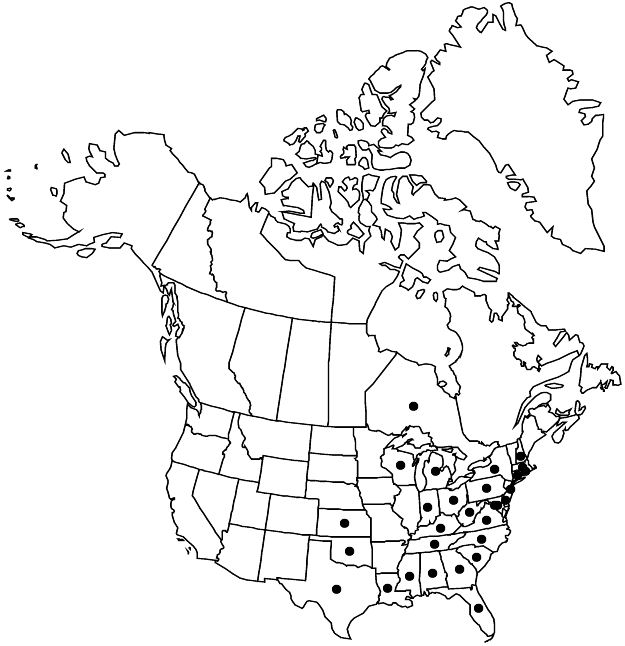Hibiscus moscheutos subsp. moscheutos
Leaf blades narrowly lanceolate to orbiculate, sometimes shallowly 3-lobed, usually glabrous adaxially. Involucellar bractlets 0.5–3.5(–4) cm, usually not ciliate. Petals white or pink, with or without red spot basally. Capsules glabrous. 2n = 38.
Phenology: Flowering mid Jun–Aug.
Habitat: Brackish and freshwater marshes, floodplain pools, beaver ponds, roadside ditches, farm ponds
Elevation: 0–400 m
Distribution

Ont., Ala., Conn., Del., D.C., Fla., Ga., Ind., Kans., Ky., La., Md., Mass., Mich., Miss., N.H., N.J., N.Y., N.C., Ohio, Okla., Pa., R.I., S.C., Tenn., Tex., Va., W.Va., Wis., introduced in Europe (sw France, n Italy, nw Portugal), Asia (Georgia).
Discussion
Hibiscus incanus usually has been treated as having hairy capsules (for example, D. M. Bates 1965; G. E. Crow and C. B. Hellquist 2000; R. K. Godfrey and J. W. Wooten 1981; B. P. G. Hochreutiner 1900; T. H. Kearney 1955b; J. K. Small 1933), which places it with subsp. lasiocarpos; the original description by Wendland and later illustration of H. incanus show that it lacks hairs and belongs here (O. J. Blanchard 2008).
Subspecies moscheutos is widespread and variable in eastern North America. In the northeastern part of its range, it corresponds to Hibiscus palustris, synonymized here. That form also extends westward across the Ontario and Erie plains to the vicinity of the south end of Lake Michigan. Distinctly different plants that agree with H. moscheutos in the narrow sense occur in southern Indiana and Ohio and southward. Along the eastern seaboard, where Hibiscus occupies the coastal marshes of nearly every county from New Hampshire to northeastern Florida, the distinction between the two taxa breaks down. General north-to-south clinal variation occurs, with local exceptions, in features that in the Midwest readily separate the two, including leaf width, leaf lobing, capsule shape and size, and frequency of adnation of petiole and pedicel. Petal color in these strikingly large-flowered plants is mostly pink throughout in the north, and white with a red base in the south; in Maryland and Delaware, there are populations in which all four possible color combinations occur (O. J. Blanchard 1976). Moscheutos-like flowers with white petals and red bases occur in New York, and pink-petaled flowers are found in North Carolina. These and similar observations by others have led to reducing the two to subspecific rank (R. T. Clausen 1949b) or fully merging them, as has been done in most recent floras; M. L. Fernald (1942c) made a case for maintaining them as separate species. See Blanchard for further discussion.
Shinnecock Indians used subsp. moscheutos as a urinary aid (D. E. Moerman 1998).
Selected References
None.